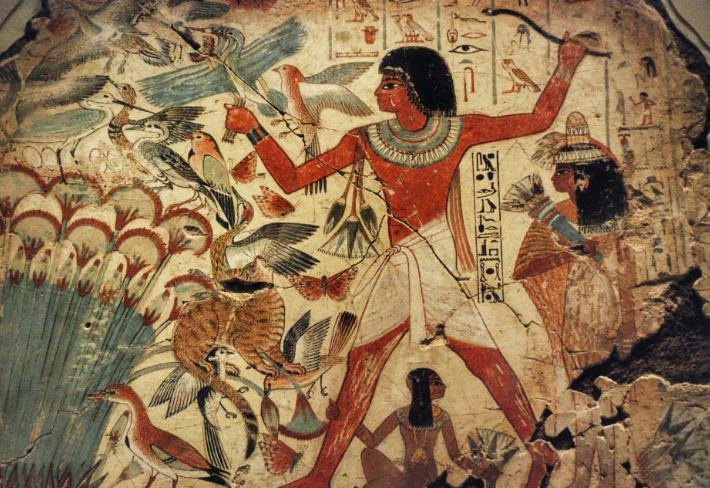The tomb of Neferhotep, a high-ranking scribe of the god Amun in the 18th Dynasty, has been reopened to the public after two decades of restoration work. The tomb, located in the Al-Khokha area on Luxor’s West Bank, is one of the most remarkable monuments of ancient Egypt, with its vivid wall paintings and sculptures depicting the life and beliefs of the tomb owner and his family.
The tomb was officially opened on Sunday, February 11, 2024, in a ceremony attended by Mostafa Waziry, Secretary-General of the Supreme Council of Antiquities, and Gonzalo Urriolabeitia, Argentina’s ambassador to Cairo. The opening was part of the efforts to promote tourism in Egypt, especially in Luxor, which is home to many archaeological treasures from the Pharaonic era.
Waziry said that the tomb introduces a significant new tourist destination to the attractions of Luxor’s West Bank, particularly amidst the surge of tourists to the country during the winter season. He added that the tomb displays beautifully painted scenes and inscriptions that reflect the high social status and religious devotion of Neferhotep, who served as the chief scribe of the temple of Amun at Karnak.

The Restoration Project
The restoration of the tomb began in 2000, under the supervision of the Egyptian Ministry of Tourism and Antiquities. A mission from Buenos Aires University in Argentina was responsible for recording and studying the tomb’s epigraphic and archaeological aspects, while a German archaeological team carried out the conservation and cleaning of the wall paintings.
Violeta Pereyra, the head of the Argentinean mission, said that the project was accomplished thanks to a grant provided by the Gerda Henkel Foundation, a German organization that supports research in the humanities and social sciences. She said that the mission documented and analyzed the tomb’s architecture, decoration, inscriptions, and objects, as well as the history and family of Neferhotep.
The German team, led by Christian E. Loeben, used a non-destructive method of cleaning the fragile wall paintings using lasers, revealing the original colors and details of the murals and the hieroglyphs. They also carried out extensive conservation measures on the wall paintings, reliefs, and sculptures to stabilize loose stone fragments, cracks, detached plaster, and paint layers.
The Tomb Highlights
The tomb of Neferhotep is one of the largest and most elaborate tombs in the Al-Khokha area, which contains several tombs of nobles and officials from the New Kingdom (1550-1069 BC). The tomb dates back to the reign of Thutmose IV (1400-1390 BC), the eighth pharaoh of the 18th Dynasty.
The tomb has a subterranean structure that is arranged east to west, evoking the regeneration of the deceased and the sun’s daily journey. From the courtyard, the sequence of rooms – outer passage, vestibule, inner passage, and cult chapel – culminate in a niche with three statue groups sculpted in the rock. The five burial chambers were undecorated. A staircase excavated on the south side of the chapel is the entrance to the main burial chamber.
The artistic quality of the tomb’s sculptures, reliefs, and wall paintings attest to the high heritage value of the monument, whose decorative program reflects the changes in funeral practices that occurred after the Amarna Period (a period of religious change that saw the capital move from the north of Egypt to the south). The tomb features scenes of the daily life, religious rituals, funerary rites, and offerings of Neferhotep and his family, as well as depictions of the gods and goddesses of ancient Egypt.
Some of the outstanding scenes in the tomb include:
- The representation of the Great Temple of Amun and its domains in the tomb’s chapel, showing the processions, festivals, and ceremonies that took place in the sacred precinct of Karnak.
- The royal palace in the tomb’s vestibule, showing the interaction between Neferhotep and the king, as well as the court life and administration of the state.
- The scenes of hunting, fishing, farming, and gardening in the tomb’s outer passage, showing the wealth and prosperity of Neferhotep and his family, as well as their enjoyment of nature and leisure activities.
- The scenes of the judgment of the dead and the journey to the afterlife in the tomb’s inner passage, showing the beliefs and hopes of Neferhotep and his family for eternal bliss and salvation.
The tomb of Neferhotep is a unique window into the ancient Egyptian civilization, culture, and religion, and a testimony to the skills and creativity of the artists and craftsmen who created this masterpiece of art and architecture.
